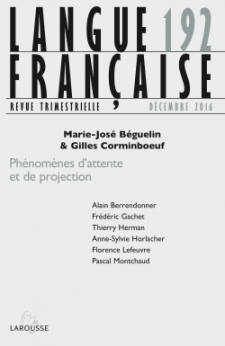
Langue française n° 192 (4/2016)
Pour acheter ce numéro, contactez-nous
Recevez les numéros de l'année en cours et accédez à l'intégralité des articles en ligne.
La projection est ce qui permet aux locuteurs d’anticiper une action et aux interlocuteurs de prévoir la suite (et la complétude possible) d’un énoncé. Ainsi, elle opère essentiellement aux niveaux actionnel et syntaxique, mais aussi aux niveaux sémantique et prosodique. Sur la base de plusieurs exemples empiriques, nous proposons une comparaison des concepts d’attente dans l’approche macro-syntaxique et de projection dans les travaux menés en linguistique interactionnelle. Pour le cadre macro-syntaxique, nous évoquons le rôle joué par l’état courant de la mémoire discursive, en distinguant différents paliers de projection. Pour la linguistique interactionnelle, nous soulignons l’importance de la séquentialité et de la temporalité de l’interaction en analysant différents cas de complétions collaboratives.
Projection provides the speakers with the possibility to foreshadow upcoming next actions, and allows interlocutors to identify syntactic trajectories and the possible completion of utterances. Hence, it relies on different resources available to interactants in talk, such as grammar, prosody and semantics, but also on the sequencing of actions. Drawing on several empirical examples, this article explores the notion of attente (expectation) as used in the macro-syntactic approach and its counterpart projection, with which interactional linguists work. In line with the macrosyntactic tradition, we explain the importance of the discursive memory while distinguishing different facets of projection. As for interactional linguistics, we analyze several cases of anticipatory collaborative completion, thereby showing that projection is contingent on the temporal and sequential features of talk-in-interaction.